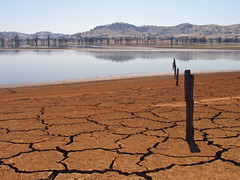 全球科學家日前在倫敦一場「壓力下的星球研討會」中,針對過去數週來持續探討的議題拋出嚴厲警告:若要降低種種不可逆的長期性氣候變遷、及其他劇烈改變地球生命支撐系統事件的風險,我們的時間所剩無幾。
全球科學家日前在倫敦一場「壓力下的星球研討會」中,針對過去數週來持續探討的議題拋出嚴厲警告:若要降低種種不可逆的長期性氣候變遷、及其他劇烈改變地球生命支撐系統事件的風險,我們的時間所剩無幾。
在場會議為期4天,共吸引2800位科學家、決策者及企業代表與會。大會檢視了種種地球的重要徵兆及負面現象,「若不立即展開行動,在地球越來越熱的狀況下,整個社會將面臨更不確定的未來。」
這次會議議是由英國皇家學會「生活與環境變化專案」所主辦,是全球永續發展高峰會(Rio+20)6月在巴西里約開議之前,最具規模的專家集會,也是且是此類專家小組曾經舉辦過、規模最大的會議。
來自澳洲國家大學(ANU)的全球氣候變化專家Will Steffen在會中演說時指出,有許多潛在危險環境「臨界點」,包括極地冰蓋的融化、北邊永凍層的解凍等,「毫無疑問,過去50年,是歷史上所能見到人與自然界關係變化最劇烈的時代」。
對於這數十年來人類活動的爆炸性發展,Steffe稱之為「劇烈的加速度」(The Great Acceleration)。
「許多人類活動在20世紀的某個時候已經達到起飛點,並於20世紀末大幅加速。『劇烈的加速度』,就是指其變化的規模和速度。」Steffe補充說,「這些都發生在人短短一生的時間中」。
「在地球上,我們能走去哪裡?」他問。
Steffen提出幾個地球狀態的關鍵指標,包括全世界人口膨脹下淡水與能源消耗持續飆漲、以及甚至還有數十億人尚缺乏生存福祉所需的基本元素。
大氣中二氧化碳的濃度越來越高。過多的磷和化肥等有機物排入海中,導致在沿海地區產生大量的死區(dead zones)。
然後科學家繼續報告:我們的大氣和海洋溫度上升,海冰、極地冰蓋和北極永久凍土層融化,海平面上升和海洋酸化,生物多樣性喪失和土地利用改變。
在整個星球的層級來看,人類正在改變全球碳循環,水循環和氮循環,Steffe警告。他擔心從永凍層釋出的溫室氣體二氧化碳的排放,因為永凍層中二氧化碳的儲藏量為大氣的2倍之多。
 Steffe並且提出了關於「發酵炸彈」的警告,這是另一個導致地球越來越熱的潛在因素,警告在融化土壤中的微生物呼吸作用,將導致「熱產生速率遠高於消散速率的臨界點」。
Steffe並且提出了關於「發酵炸彈」的警告,這是另一個導致地球越來越熱的潛在因素,警告在融化土壤中的微生物呼吸作用,將導致「熱產生速率遠高於消散速率的臨界點」。
「當我們看到地球過去呈現的反應,上述種種環境臨界點都是單一系統的一部份。」
「重點是,在這個世紀,我們可能會達到某種門檻。要不我們扭轉了很多這些趨勢──二氧化碳的趨勢、過度伐木等等;或者我們繼續施壓給地球且跨過此門檻,讓這些劇變因子更活躍,而改變整個世界進入一個全新的、更溫暖的狀態。」
另一位會議演講者Diana Liverman則表示:「從一些跡象可看出,某些驅動全球變遷的事件正在減緩或改變。」
Liverman現任亞利桑那大學環境研究所協同主任,也是英國牛津大學訪問學者。他表示,地球進入一個由單一物種(人類)深刻影響生態系統,全新的地質紀元。這影響如此深遠因而以她命名為「人類世」。
「地球的壓力會慢慢舒緩」Liverman指出,「人口增長漸緩且將趨於平穩。每單位生產所產出的碳排也在下降,農業集約化後某些地區森林將慢慢長回。」
「另一方面,」她說道,「每人平均資源消耗,在某些地區已經居高不下,卻在某些許多窮人連人類基本需求都無法滿足的新興經濟體急遽上升。在一些國家,人們無論是碳、水和其他資源都消耗得太多,我們想要扭轉乾坤,還有條漫長的路要走。」
以下一段1分15秒的影片呈現歷史上,隨時間推移,人類的全球二氧化碳排放量分佈情況。此影片呈現自1750年英國的工業革命後,二氧化碳排放開始急速增加,漸漸範圍擴張至全歐洲、北美洲及亞洲,最後遍佈全球。
Scientists at the Planet under Pressure conference in London today added their stern warning to others issued over the past several weeks - time is running out to minimize the risk of irreversible, long-term climate change and other dramatic changes to Earth's life support system.
The 2,800 scientists, policymakers and business representatives opened their four-day conference with a reading of Earth's vital signs and an ominous prognosis, "without immediate action, societies everywhere face an uncertain future on what may become a much hotter planet."
Lake Hume, the furthest downstream of the major reservoirs on Australia's Murray River system (Photo by Tim Keegan)
Hosted by The Royal Society UK's Living with Environmental Change program, this is the largest gathering of experts in global sustainability ahead of the UN Rio+20 summit in Brazil in June and the largest gathering ever of such a group of experts.
To Professor Will Steffen, a conference speaker, there are several potentially dangerous environmental "tipping points," among them the melting of the polar ice sheets and the thawing of perennially frozen northern permafrost soils.
Steffen, a global change expert from the Australian National University, says, "The last 50 years have without doubt seen the most rapid transformation of the human relationship with the natural world in history."
Steffen calls the "explosion in human activity" over the past several decades, "The Great Acceleration."
"Many human activities reached take-off points sometime in the 20th century and sharply accelerated towards the end of the century. It is the scale and speed of the Great Acceleration that is truly remarkable," Steffen said. "This has largely happened within one human lifetime."
"Where on Earth are we going?" he asks.
Key indicators of the planet's state, conference speakers agreed, include growing consumption of freshwater supplies and energy by swelling numbers of people worldwide, even as billions of people lack even the most basic elements of well-being.
Professor Will Steffen (Photo by TEDx Canberra)
There are higher levels of carbon dioxide in the atmosphere. Phosphorus extraction and fertilizer production send nutrient runoff into the sea, causing huge dead zones in coastal areas.
Then the scientists report, we have rising air and ocean temperatures, melting sea ice, polar ice sheets and Arctic permafrost, rising sea levels and ocean acidification, biodiversity loss and land use changes.
At a planetary level, humanity is altering the global carbon cycle, water cycle and nitrogen cycle, warns Steffen. He worries about the release of the greenhouse gas carbon dioxide from melting permafrost because it stores the equivalent of twice the carbon in the atmosphere.
Steffen warns about the "compost bomb," another potential contributor to a hotter Earth. The microbial respiration in thawed soils, he says, are "leading to a tipping point where heat is produced more rapidly than it can be dissipated."
Permafrost on the Yukon Delta National Wildlife Refuge, Alaska (Photo by USFWS Alaska)
"All these environmental tipping point phenomena are part of a single system," that Steffen says becomes clear, "when we look at how the Earth has behaved in the past."
"The key point is," he said, "we may reach a threshold for the Earth as a whole this century. Either we turn around a lot of these trends - the carbon dioxide trend, deforestation and so on - or we allow them to continue and push the Earth as a whole across a threshold whereby a lot of these tipping elements are activated and the world moves into a new, much warmer state."
"There are signs that some drivers of global change are slowing or changing," said another conference speaker, Professor Diana Liverman, co-director of the Institute of the Environment at the University of Arizona and visiting Oxford University academic.
Liverman says Earth has entered a new geological epoch hallmarked by the profound ecosystem impacts of one species - humans - so much so that it marks an entirely new geological timespan that she calls the "Anthropocene."
Pressure will ease off the planet somewhat, says Liverman. "Population growth is slowing and will level off; the intensity of energy and carbon required for a unit of production is declining; agricultural intensification is slowing and forests are starting to expand in some regions."
"On the other hand," she said, "average resource consumption per person, already high in some regions, is growing steeply in emerging economies even as many poor people cannot meet basic human needs. In some countries people are consuming far too much, including carbon, water and other resources embodied in trade. We have a long way to go to turn things around."
The 1:10 minute time-lapse history of human global CO2 emissions, online at www.youtube.com/watch?v=MEMse22h8c8, captures the growth of CO2 emissions from their start with the UK's Industrial Revolution in 1750 and radiating across Europe, to North America, then Asia and worldwide.







